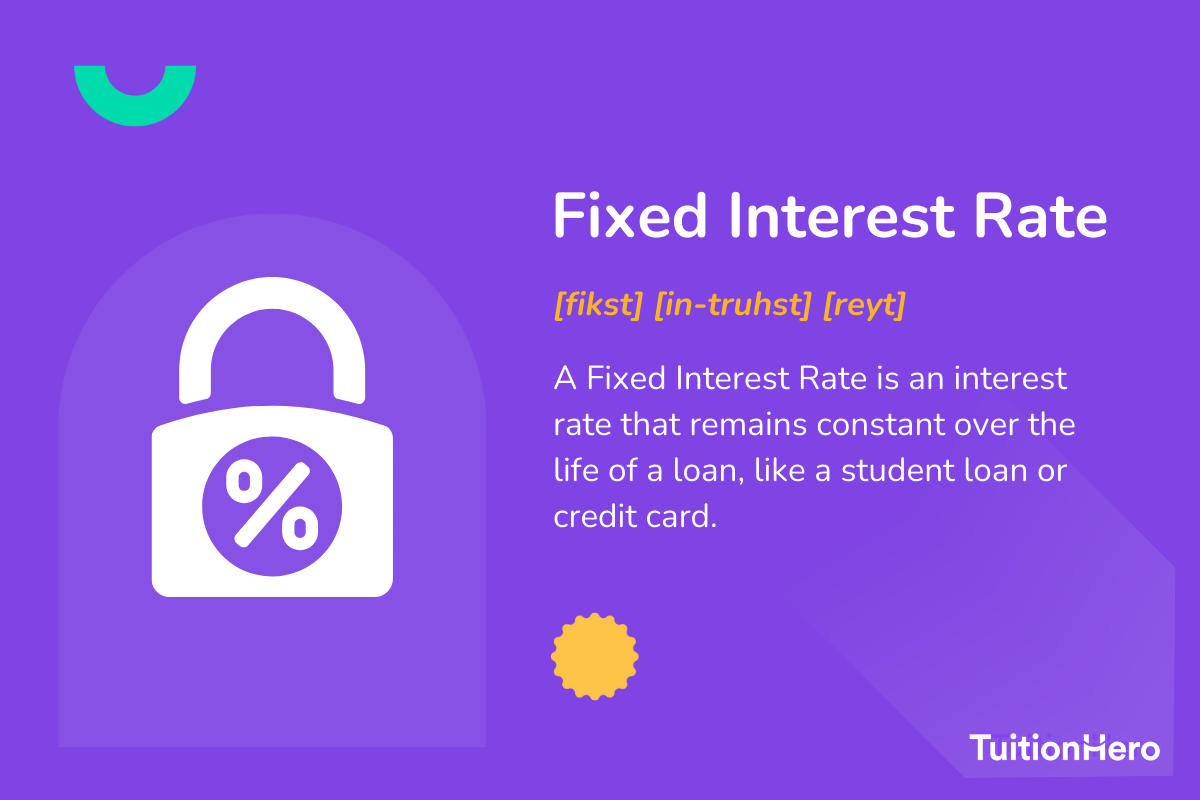Advertiser Disclosure
Last update: November 17, 2024
5 minutes read
Fixed vs Variable Interest Rates: The Key Differences
What's the difference between fixed and variable rated? Understand the difference between fixed vs. variable rates for loans. Master the pros and cons and how to choose the right fit for your financial needs.

By Brian Flaherty, B.A. Economics
Edited by Rachel Lauren, B.A. in Business and Political Economy
Learn more about our editorial standards



By Brian Flaherty, B.A. Economics
Edited by Rachel Lauren, B.A. in Business and Political Economy
Learn more about our editorial standards
Confused about fixed vs variable rates in loan options? Let's shed some light on this question. A fixed rate remains the same throughout the loan's life, while a variable rate changes with the market. In this post, you'll learn the details of these two types of rates, their pros and cons, and know which might work out better for your own financial situation.

Key takeaways
- Fixed-rate loans promise steadiness with unchanging interest rates throughout the loan life
- Variable-rate loans offer potential savings, with rates that fluctuate in line with the market
- Variable rates are typically tied to benchmark rates plus an added margin, which stays the same after the loan is closed
Understanding fixed vs variable rates
At its simplest, the choice between fixed vs variable rates depends on predictability versus potential savings. With a fixed rate, you enjoy the stability of constant payments, but a variable rate could lead to lower costs if market interest rates fall, or a higher rate if they rise.

What is a fixed-rate loan, and how does it work?
A fixed-rate loan is a type of loan where the interest rate stays the same throughout the loan's repayment period. This steady rate makes budgeting easier, as your repayment amount won't fluctuate with the market conditions.
Advantages and disadvantages of fixed-rate loans
Fixed-rate loans come with their own set of pros and cons that should be taken into consideration when deciding what type of loan to get. Let's break them down.
- Stable monthly payments: You know exactly what you're going to pay every month, making budget planning simpler.
- Immunity from market changes: Even in a changing economic climate, your loan repayments won’t increase.
- Clear cost calculations: Easy to gauge the total loan cost since the rates aren’t changing.
- No benefit from market drops: If interest rates drop in the market, you won’t get any savings.
- Pay more to refinance: If lower rates tempt you to refinance, it will cost you extra in fees.
- Rates may be higher initially: Fixed rates might start higher than the variable rates.
Variable rate loans
In contrast, a variable-rate loan has an interest rate that varies according to market changes. Initially, these might be lower than fixed rates, but remember there's always a chance they'll increase. These are a good fit for those who aren't bothered by surprises or plan to pay off the loan quickly.
How do variable-rate loans work?
Variable rate loans are typically linked to benchmark rates like the LIBOR (London inter-bank-offered rate) or the prime rate. However, be aware that the LIBOR is scheduled to be phased out by 2023, and will likely be replaced by SOFR-based (Secured overnight finance rate) indexes.
Here’s how it plays out: lenders use these benchmarks as a starting point for their variable rate loans and add a certain margin to it. This margin, which is the added percentage points after the initial rate period, remains constant once the loan is closed.
Your credit score, loan type, and chosen lender heavily influence the final margin and interest rate you're offered. For example, with a prime rate of 4.25% and a margin of 10%, you'd be looking at an interest rate of 14.25%.
Advantages and disadvantages of variable-rate loans
As we dive deeper into this conversation, let's take a moment to weigh the pros and cons of getting variable-rate loans:
- Potential for lower payments: If market interest rates drop, so do your payments!
- Initial rates can be attractive: Variable loan rates frequently start lower than fixed rates.
- Enjoy tempting intro rates: Some lenders offer tempting rates when you initially take out a loan.
- Risk of increased payments: If interest rates increase, expect to see that impact your monthly payments.
- Potential for higher long-term cost: Depending on market trends, your total loan cost might exceed a fixed rate equivalent.
- Predictability challenges: Constant rate changes might test your skill in estimating loan affordability.
How do interest rate caps work in variable-rate loans?
Given the risk of variable rates skyrocketing, most come with interest rate caps to keep the cost from spiraling upward. There are typically three types of caps:
- Initial cap: This limits how much the interest rate can change initially.
- Periodic cap: This is how much the rate can change during each adjustment period.
- Lifetime cap: This sets the limit on how high the rate can go altogether.

TuitionHero Tip
Remember, fixed-rate loans can offer long-term affordability despite these caps, especially in a low-interest-rate environment.
How do you choose between fixed vs variable rates?
Choosing between fixed and variable rates isn't a one-size-fits-all solution and depends on your financial situation and specific loan details.
Consider these key factors to determine which rate type is best for you:
- Term lengths: Understand that a longer term means more interest, while a shorter term may have higher monthly payments.
- Lender fees: Carefully look over origination fees, application fees, underwriting fees, etc., that can increase your total loan cost.
- Expected income: Analyze how likely you are to afford the loan long-term, including potential income changes.
You’ll also want to consider how you might respond to unexpected changes in your interest payments. Personally, I have some flexibility in my budget and don’t mind the occasional surprise. For those reasons, I’m more comfortable with a variable rate than some of my friends.
Compare private student loans now
TuitionHero simplifies your student loan decision, with multiple top loans side-by-side.
Compare Rates
Dos and don'ts of choosing between fixed and variable rates
It's a tug of war between stability and potential savings when choosing between fixed and variable rates. But don't worry! Here is a helpful table to guide you with the do’s and don'ts when deciding between these two choices:
Do
Research current market trends
Consider your long-term financial stability
Consider your risk tolerance
Plan for future financial changes
Don't
Choose without comparing rates
Ignore your financial plan
Forget to read the fine print
Assume rates won't change

Why trust TuitionHero
At TuitionHero, we simplify college financing. Whether you're choosing a private student loan, deciding between fixed or variable rates, or refinancing, we've got you covered. We also assist with FAFSA, scholarships, and selecting the right credit card. Our goal is to make college finance less stressful, providing clarity and confidence for students and parents.
Frequently asked questions (FAQ)
Variable-rate loans generally start with lower rates compared to fixed-rate loans due to their underlying risk for the borrower. However, they can change over time based on market fluctuations.
Yes, switching from a variable rate to a fixed rate is possible through loan refinancing. But keep in mind, refinancing can involve additional costs and fees. You can learn more about this on our Student Loan Refinancing page.
Predicting exact market changes can be challenging. Experts generally rely on economic indicators and trends to make educated predictions. It's always wise to consult professionals or use trusted sources like TuitionHero for guidance.
Your credit score, the type of loan you're applying for, and specific lender policies play a key role in determining the initial margin on variable loans. A solid credit history often can secure you more favorable terms.
Final thoughts
Choosing between fixed and variable loan rates might feel like a challenge. But with the right information, you can step ahead with confidence. Keep in mind that while your financial matters are yours, you don't have to figure them out alone. With a trusted friend like TuitionHero, you can sail through these financial decisions much more easily.
Sources
Author

Brian Flaherty
Brian is a graduate of the University of Virginia where he earned a B.A. in Economics. After graduation, Brian spent four years working at a wealth management firm advising high-net-worth investors and institutions. During his time there, he passed the rigorous Series 65 exam and rose to a high-level strategy position.
Editor

Rachel Lauren
Rachel Lauren is the co-founder and COO of Debbie, a tech startup that offers an app to help people pay off their credit card debt for good through rewards and behavioral psychology. She was previously a venture capital investor at BDMI, as well as an equity research analyst at Credit Suisse.
At TuitionHero, we're not just passionate about our work - we take immense pride in it. Our dedicated team of writers diligently follows strict editorial standards, ensuring that every piece of content we publish is accurate, current, and highly valuable. We don't just strive for quality; we aim for excellence.
Related posts
While you're at it, here are some other college finance-related blog posts you might be interested in.
Shop and compare student financing options - 100% free!

Always free, always fast
TuitionHero is 100% free to use. Here, you can instantly view and compare multiple top lenders side-by-side.

Won’t affect credit score
Don’t worry – checking your rates with TuitionHero never impacts your credit score!

Safe and secure
We take your information's security seriously. We apply industry best practices to ensure your data is safe.
Finished scrolling? Start saving & find your private student loan rate today





